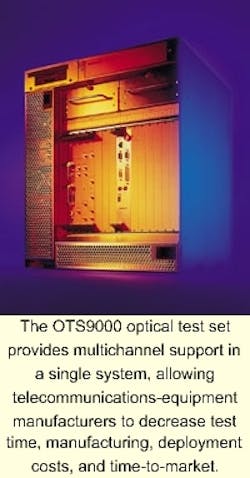Tektronix test set offers 10-Gbit/sec analysis for SONET/SDH DWDM systems
By Robert Pease
Tektronix (Beaverton, OR) announced a new measurement test set, the OTS9000, with modules to support up to 10-Gbit/sec Synchronous Optical Network (SONET) and Synchronous Digital Hierarchy (SDH) analysis. With test and measurement companies continually playing "catch up" with rapidly advancing optical technology, the OTS9000 is designed to meet some important needs of high-speed networking-equipment manufacturers.In just a few short years, fiber-optic telecommunications networks have been pushed from 622 Mbits/sec to an astounding 10 Gbits/sec and beyond by an insatiable appetite for more bandwidth capacity. Dense wavelength-division multiplexing (DWDM), once praised for dividing the bandwidth on a single fiber into four, eight, or 16 channels, is currently under development to provide even more divisions, with Lucent Technologies' Bell Labs recently announcing successful testing of 1,022 channels over one fiber.
Tektronix believes its OTS9000 platform brings measurement in line with current in-use technology and offers several advantages for manufacturers, such as a shorter time-to-market, reliable conformance testing, reduced manufacturing costs, and smaller test system-space requirements. The new platform boasts flexible, card modular architecture that enables expansion as well as adaptability to new capabilities as they become available.
"Essentially, it is difficult to stay ahead in the test and measurement industry, so things tend to develop in stages," says Dana Cooperson, a senior analyst at RHK, a California-based communications industry analyst and consulting firm. "When things are really getting started in a particular development, such as for 10-Gbit/sec transmission rates, the first test products tend to be very open-ended in terms of functionality and cost. The second stage sees a more general market with more targeted applications. Some ASICs [application-specific integrated circuits] may have been designed to handle some of the functions, enabling new products to be more focused and less expensive, which is where the new Tektronix product sits. There will be others coming with similar application-specific designs."
Based on adopted "small-footprint" standards, the new modular platform saves space, lowers costs, and provides users with a more integrated test solution. According to Tektronix, the cost-effectiveness of the platform stems from its dense, multichannel support in a single system, with cards available in three configurations-transceiver, transmitter-only, and receiver-only. This architecture allows a manufacturer, for example, to design a test system using an optical splitter, with one transmitter for multiple receivers, providing substantial cost savings to the user by lowering the test cost-per-channel and the time it takes to conduct the test. A single OTS9000 platform can support up to three 10-Gbit/sec transceivers.
The test system also boasts a unique variable-receiver threshold that allows manufacturers to perform accelerated bit-error-rate (BER) testing, enabling accelerated testing of more components. The test system uses a Windows NT interface that is easy to use and familiar to users as well as a remote-control capability for automated testing. Tests include performance verification via BER testing, SONET/ SDH overhead conformance testing, and stress testing of a particular network element.
"These kinds of designs are not trivial," says Cooperson. "It's a different kind of development process than that to develop a network element. When you build test equipment, you have to be very flexible. Producing a box that is very much standards-based is a real change in strategy for Tektronix. This product is standards-based in both interfaces and internally along with significant expandability. Not only is this a new instrument in terms of measurement capability, it's really a platform than can also be used for other applications."
According to Cooperson, the next step for the evolution of 10-Gbit/sec test boxes will be portable products designed for field use. At the field level, more units can be sold and pricing normally decreases as portable units tend to become application-specific, more automated, less programmable and, therefore, sporting lower price tags. However, field test equipment de signed for 10-Gbit/sec SONET/ SDH is still awaiting customer demand.
"When you're dealing with SONET, the testing tends to be done at the tributary rate," says Cooperson. "So if you're dealing with an OC-192 [10-Gbit/sec] system, the testing would all be done at OC-48 [2.5 Gbits/sec] or below. So right now, there still isn't a lot of call for OC-192 test boxes in the field, at least not for SONET testing. But as the channel speeds for WDM [wavelength-division multiplexing] have grown to include OC-192, there will be some call for field-portable OC-192 testing for WDM systems but not at tremendous volumes yet."
Even so, Wavetek Wandel Goltermann (WWG-Research Triangle Park, NC) isn't waiting around for customer demand. Just days after the Tektronix OTS9000 announcement, WWG introduced its field test version, the ANT-10Gig, for 10-Gbit/sec SONET/SDH field testing. The product will sell for around $300,000 and represents the first product within the final evolutionary phase associated with network test equipment.
"Test-equipment customers are asking for products that don't require them to throw out everything they already have," adds Cooperson. "They want to add onto what they have and do it in a very effective and efficient way. I believe Tektronix has listened to that and acted upon it with this product."

